Out there, on a real coral reef, corals find all the chemical elements they need to grow and thrive from the natural seawater all around them.
They have evolved over millennia to utilise those abundant elements, particularly Calcium and Carbonate, to construct their skeletons, and there is, in effect, an infinite supply available to them.
However, in the closed environment that is a reef tank, those elements will deplete over time so we need to supplement that supply by dosing.
Dosing simply means periodically adding a solution of the chemical elements to keep them topped up to the ideal levels.
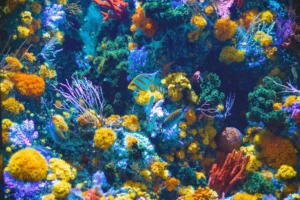
Table of Contents
- Why Dose a Reef Tank
- What to Dose in a Reef Tank
- Water Parameters For a Reef Tank
- Salt Mix for a Reef Tank
- Testing for Alkalinity, Calcium and Magnesium
- Alkalinity Dosing in a Reef Tank
- Calcium Dosing in a Reef Tank
- Magnesium Dosing in a Reef Tank
- Dosing Supplements For Reef Tanks
- How to Dose a Reef Tank
- Dosing Pumps For Reef Tanks
- Reef Tank Dosing FAQs
Why Dose a Reef Tank
Firstly, if you are keeping a fish-only tank with NO corals, then you will not need to dose. Regular water changes will replenish the loss of any elements over time.
Similarly, if you are only keeping a few easy soft corals, like Zoanthids, Mushroom and Toadstool coral, Xenia, Green Star Polyps and Kenya Trees, water changes will probably be enough to replenish the loss of any elements used by the corals.
However, if you are keeping any LPS or SPS corals, or you have Coralline Algae, then the levels of Calcium, Carbonate and Magnesium will deplete over time.
Even if the levels of those elements only deplete by a very small amount, a water change will NOT fully replace them.
Let’s say the level of Calcium in your water has dropped by 2%. So, now your water has 98% of the Calcium it needs. You then do a 25% water change.
The newly added 25% of the water has 100% Calcium but the old, remaining, 75% of the water still has 98% Calcium.
Combined the overall level of calcium in the water is now (3/4 x 98) + (1/4 x 100) = 98.5%
So, as you can see, the level of Calcium, (and Carbonate and Magnesium) will deplete over time and we need to replace them by supplemental dosing.
What to Dose in a Reef Tank
As already stated, corals use Calcium and Carbonate (more commonly referred to as Alkalinity) to construct their chalk skeletons and as they grow will deplete these elements in the water.
Magnesium allows Calcium and Alkalinity to stay free in the water and not calcify so they can be absorbed and used by the coral.
The relationship between these three chemical elements is complex and you can find out more here if you wish.
You just need to know that they will deplete over time, you will need to measure this depletion and correct it by supplemental dosing.
Water Parameters For a Reef Tank
As a rough guide these are the water parameters that you should aim for:-
| Alkalinity (KH) | 7-11 dKH |
| Calcium | 420 – 460 ppm |
| Magnesium | 1250 – 1380 ppm |
Salt Mix for a Reef Tank
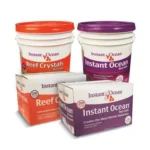
The topic of which salt mix to use in a reef tank will likely be the subject of a future article but for now just be aware that different salt mixes have different levels of Alkalinity, Calcium, Magnesium and other trace elements.
The best salt mix for a reef tank will have those key elements at a higher level when mixed to the same salinity.
For example, Instant Ocean Reef Crystals contain “essential ocean reef elements in concentrations greater than those found in natural sea water.” Whereas, Instant Ocean Salt closely mimics natural sea water.
Similarly, Red Sea Salt typically mixes to an Alkalinity of 8 dKH, Calcium of 410 mg/l, and Magnesium of 1280 mg/l at a salinity of 35 ppt.
Whereas, Red Sea Coral Pro Salt typically mixes to an Alkalinity of 12 dKH, Calcium of 465 mg/l, and Magnesium of 1390 mg/l at a salinity of 35 ppt.
So, it’s important to choose a salt mix that most closely resembles the levels you desire to keep.
Always use RO water for making your saltwater as tap water contains high numbers of dissolved solids, phosphates and nitrates which can cause many different issues.
Testing for Alkalinity, Calcium and Magnesium
In order to measure the depletion of these elements you will need to test the levels on a regular basis. For more detail, check out our article, How to Test Your Saltwater Fish Tank and for the test kits you’ll need to do this, we review the top ones here, Best Test Kits for a Saltwater Fish Tank.
Alkalinity Dosing in a Reef Tank

In aquariums, Alkalinity is more commonly known as KH or “carbonate hardness” and the ideal alkalinity in a reef tank is between 8 -12 dkh with the higher end being most desirable for LPS and SPS corals.
Low alkalinity in a reef tank can lead to coral bleaching, tissue loss and pH swings, while high alkalinity in a reef tank may cause calcium to precipitate out of the water and cause calcium levels to fall rapidly.
How to Raise Alkalinity in a Reef Tank
Firstly, take care not to raise alkalinity by more than 1 dKH per day.
- You can use Sodium Bicarbonate (baking soda) to raise alkalinity. 1 teaspoon of baking soda per 35 litres of water will raise the alkalinity level or dKH by around 1 point.
- Soda Ash can also be used but care is needed as this will also raise the PH.
- You can use one of the many commercially available carbonate supplements but be sure to carefully follow the directions given. Many of these also come as ‘Two-Part’ with a separate Calcium supplement.
You can also use Kalkwasser or limewater if you want to balance both the calcium and alkalinity.
If, even after adding an alkalinity supplement, you still find you are unable to raise the alkalinity level, check the level of magnesium. A low magnesium level will stop the alkalinity supplement from working as it should.
How to Lower Alkalinity in a Reef Tank
If the alkalinity level in your tank should ever get too high, simply stop dosing until the excess has been used by your corals.
You could also try raising the calcium level by small amounts until the two are back in balance.
Testing Alkalinity in a Reef Tank
Testing alkalinity should be done on a weekly basis.
Calcium Dosing in a Reef Tank
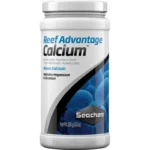
The ideal calcium level in a reef tank is between 380 – 470 ppm with the higher end, again being more suitable for LPS and SPS corals.
Low calcium in a reef tank can lead to low coral growth or loss, discoloration and a fall in pH, while high calcium in a reef tank (more than 500 ppm) may cause alkalinity levels to fall.
How to Raise Calcium in a Reef Tank
Take care not to raise calcium by more than 100 ppm per day.
- You can use Calcium Chloride to raise the calcium level. Use the flake variety, rather than powder, and mix the flakes in RO water to form a solution that can then be added to your tank. Proceed slowly and test frequently.
- Kalkwasser or limewater can also be used but care is needed as this can raise the PH.
- There are numerous Calcium supplements available on the market with several of these being ‘Two-Part’ with a separate carbonate supplement.
Always proceed slowly as a sudden increase in calcium can dramatically increase the PH level.
Remember also to check the level of magnesium. A low magnesium level may prevent any calcium supplement from working as it should.
How to Lower Calcium in a Reef Tank
If calcium levels get too high, simply stop dosing until the excess has been used by your corals.
Testing Calcium in a Reef Tank
Testing the calcium level should be done every week.
Magnesium Dosing in a Reef Tank
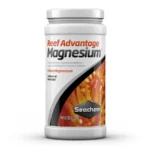
The ideal magnesium level in a reef tank is between 1250 – 1350 ppm with the natural magnesium level in seawater being around 1285 ppm.
To grow their skeletons and shells, corals and invertebrates metabolise calcium and carbonate and magnesium allows calcium and carbonate to stay free in the water and not calcify.
Low magnesium in a reef tank will impact the calcium absorbing capacity of corals leading to low growth or loss. It will also result in a loss in PH.
High magnesium in a reef tank may result in the loss of carbonate alkalinity
The magnesium and calcium ratio should be roughly 3 to 1, so, to maintain a calcium level of 450, the magnesium level should be 1350.
How to Raise Magnesium in a Reef Tank
- You can use dissolved Epsom salts and magnesium chloride hexahydrate to form a solution for dosing but the formula is somewhat complicated so we would not recommend this route.
- There are various pre-prepared Magnesium supplements available to buy at your local store or online. They are inexpensive so most reef tank keepers prefer to use one of them.
Proceed slowly and do not raise magnesium by more than 50 ppm per day
How to Lower Magnesium in a Reef Tank
If you overshoot and raise magnesium levels too high, don’t panic, simply stop dosing until the excess has been absorbed.
Testing Magnesium in a Reef Tank
Test the Magnesium level bi-weekly.
Dosing Supplements For Reef Tanks
As mentioned above, there are various supplements available on the market for dosing alkalinity, calcium and magnesium and we look at the best ones here, Best Reef Tank Dosing Supplements.
How to Dose a Reef Tank
Regardless of which supplement you are using you will need a systematic method of adding it to your reef tank.
How often, and how much, of each supplement to add will vary greatly from tank to tank. You will first need to test very regularly, probably daily at first, to establish which elements are being used up, how quickly, and by how much.
Once you have a better idea you can start to establish a schedule of when to dose each element to keep your water parameters at the levels you want.
You will almost certainly start by dosing each element manually and we suggest you dose daily for Alkalinity, weekly for Calcium, and bi-weekly for Magnesium.
Check out our article, DIY Two Part Dosing Recipe, for more detailed instructions.
For smaller tanks (under 100 liters) this is probably all you’ll need to do, however for larger tanks with more, and more demanding, corals you will need a way to automate the process.
Dosing Pumps For Reef Tanks
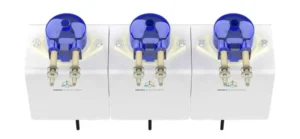
You will probably find, quite quickly, that manual dosing becomes a chore and one that can be easily forgotten, and if you’re away for a few days, who is going to take the task on?
That’s where a dosing pump comes in…
A dosing pump is a peripatetic pump that will dose a fixed amount of liquid at a set time. They are programmable, often over wifi, to allow you to set how much you want to dose and when.
That means you can set and forget (provided the containers containing your dosing solutions are kept topped up).
It also means you do not have to dose each element all at once, rather you can spread the dosing throughout the day or week which will mimic a far more natural process in your reef tank.
Our Best Dosing Pumps For Reef Tanks article reviews the top dosing pumps.
For information about carbon or vodka or vinegar dosing see out article, Carbon Dosing in a Reef Tank.
Reef Tank Dosing FAQs
What should I be dosing in my reef tank? – LPS and SPS corals use calcium and carbonate (KH) to grow their skeletons. Over time these elements will reduce in your tank water and need to be replaced by dosing.
Magnesium prevents calcium and carbonate from calcifying so they can be absorbed and used by corals.
There are many dosing supplements available but we prefer our own DIY Dosing Recipe.
What are the ideal parameters for a reef tank? – You should aim to be in the following ranges:-
- Alkalinity (KH) : 7-11 dKH
- Calcium : 420 – 460 ppm
- Magnesium : 1250 – 1380 ppm
What corals don’t require dosing? – Soft corals, like Zoanthids, Mushroom and Toadstool coral, Xenia, Green Star Polyps and Kenya Trees, may not require dosing as water changes will probably be enough to replenish the loss of any elements used.
Do I need a dosing pump for reef tank? – You can, of course, choose to add any dosing supplements manually. However, as dosing needs to be done consistently and regularly this will quickly become a chore.
A programmable reef tank dosing pump will dose a fixed amount of liquid at a set time. You can then easily spread your dosing schedule throughout the day/week.
